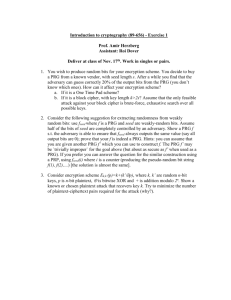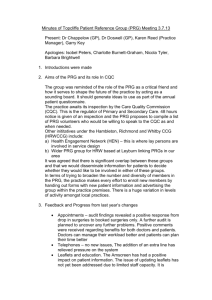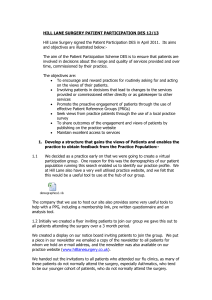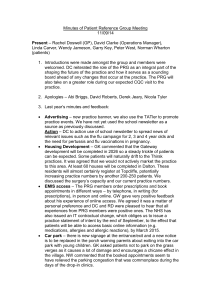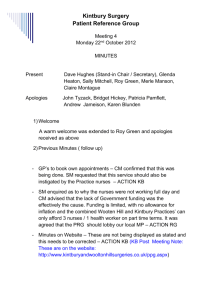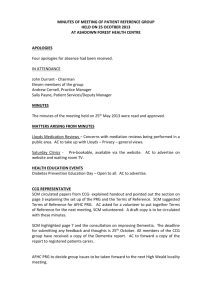Patient Participation DES SLA 2013 2014
advertisement
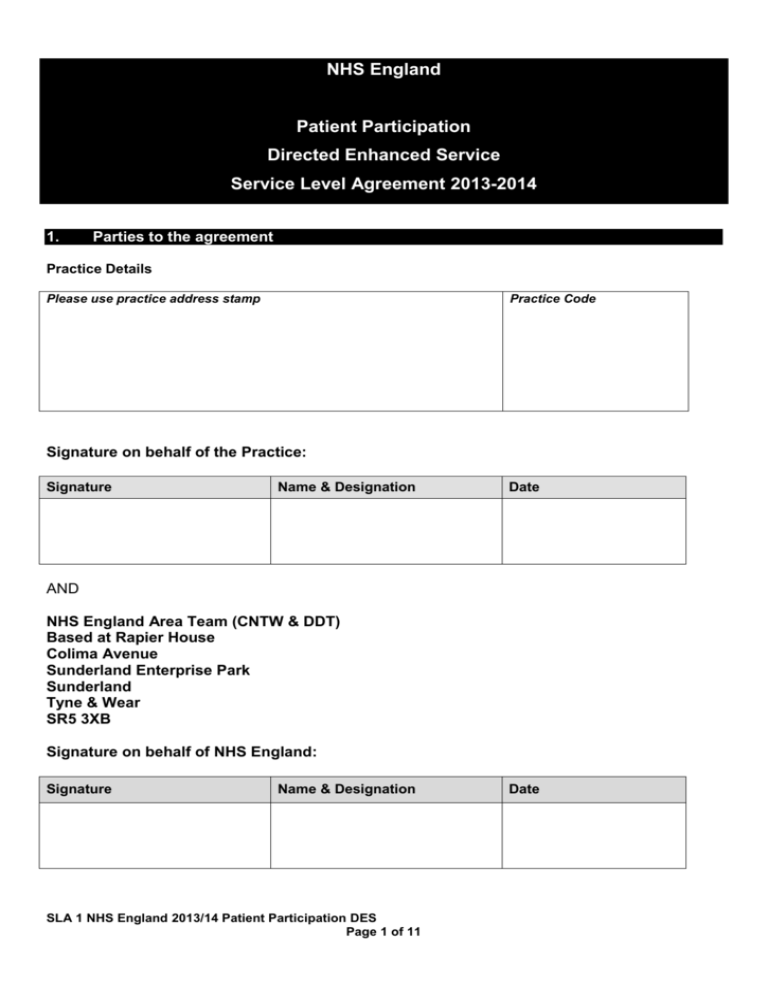
NHS England Patient Participation Directed Enhanced Service Service Level Agreement 2013-2014 1. Parties to the agreement Practice Details Please use practice address stamp Practice Code Signature on behalf of the Practice: Signature Name & Designation Date AND NHS England Area Team (CNTW & DDT) Based at Rapier House Colima Avenue Sunderland Enterprise Park Sunderland Tyne & Wear SR5 3XB Signature on behalf of NHS England: Signature Name & Designation SLA 1 NHS England 2013/14 Patient Participation DES Page 1 of 11 Date 2. Agreement Period This agreement covers the period from 1 April 2013 – 31 March 2014 and agreement ends on 31 March 2014. 3. Terms of the DES The detail of the DES has been set out in the service specification attached. 4. Payment The practice will receive an overall payment of £1.10 per registered patient (as per list size at 1 April 2013) per annum based on its achievement of the DES as highlighted in section 7 of the service specification attached. Payment will be made to practice by 30 June 2014. SLA 1 NHS England 2013/14 Patient Participation DES Page 2 of 11 Directed Enhanced Service Specification Patient Participation 1. Introduction This DES should be read in conjunction with: Patient Participation Directed Enhanced Services (DES) for GMS contract 2013/14, Guidance and audit requirements (available on the NHS Employers Website) http://www.nhsemployers.org/Aboutus/Publications/Documents/2013_14_patient_participation_DES_guidance .pdf National Health Service England, GMS Statement of Financial Entitlements Directions 2013- section 10 Patient Participation Scheme https://www.gov.uk/government/uploads/system/uploads/attachment_data/file/187049/GMS_Statement_of_Fi nancial_Entitlements_Directions_2013.pdf National Health Service England, The Primary Medical Services (Direct Enhanced Services) Directions 2013 https://www.gov.uk/government/uploads/system/uploads/attachment_data/file/127322/Primary-MedicalServices-Directed-Enhanced-Services-Directions-2013.pdf.pdf 2. Service Aim The purpose of the Patient Participation DES is to ensure that patients are involved in decisions about the range and quality of services provided and, over time, commissioned by their practice. It aims to encourage and reward practices for routinely asking for and acting on the views of their patients. This includes patients being involved in decisions that lead to changes to the services their practice provides or commissions, either directly or in its capacity as gatekeeper to other services. 3. Principles of the DES 3.1 Evidence Base Practices signing up to the DES will establish a Patient Reference Group (PRG). This may be a formal Patient Participation Group (PPG) or a similar group that is representative of the practice population, which would feed in its views alongside the findings from local practice surveys and agree with the practice the priority areas for possible change. This would result in an action plan to be agreed between the practice and the PRG. The practice must be able to clearly demonstrate that it has established a PRG comprising only of registered patients and has used its best endeavours to ensure that the PRG is a representative cross section of the practice population. Practices must publish a Local Patient Participation Report on their website (where a practice does not already have a website, one must be set up). Payment will be based on the evidence that each successive component has been achieved. Evidence will be in the form of a report which must have been completed and published on the practice’s website by no later than the 31 March 2014. SLA 1 NHS England 2013/14 Patient Participation DES Page 3 of 11 3.2 Objectives There are a number of key steps (mainly annual) to this DES: Step 1: Develop a structure that gathers the views of patients and enables the practice to obtain feedback from the practice population, e.g. a PRG Step 2: Agree areas of priority with the PRG Step 3: Collate patient views through the use of a survey Step 4: Provide the PRG with the opportunity to discuss the survey findings and reach agreement with the PRG on changes to services Step 5: Agree an action plan with the PRG and seek PRG agreement to implementing any changes Step 6: Publicise the actions taken and subsequent achievement More details on these steps are set out below. 3.3 Expected Outcomes An appropriate sample size should be discussed and agreed with the PRG and should be methodologically appropriate for the survey being used. Equivalent ongoing engagement with a smaller number of patients would also allow the use of real-time feedback as mentioned in the white paper, which can be found on the Department of Health website. http://www.dh.gov.uk/prod_consum_dh/groups/dh_digitalassets/@dh/@en/@ps/documents/digitalasset/dh_117794.p df 4. Service Requirements The DES aims to promote the proactive engagement of patients through the use of effective Patient Reference Groups (PRGs) and to seek views from practice patients through the use of a local practice survey. The outcomes of the engagement exercise and the views of patients are to be reflected in a Local Patient Participation Report, which must be published on the practice website by 31 March 2014. Where a practice does not already have a website, one must be set up no later than 28 February 2014. See section 5 for steps to complete as part of this DES. 5. Service Delivery 5.1 Step 1: Develop a Patient Reference Group (PRG) Where a practice is engaging in this DES for the first time in 2013/14, then the practice must develop a properly constituted structure that both reflects and gains the views of its registered patients and enables the practice to obtain feedback from a cross section of the practice population which is as representative as possible. Practices that have previously engaged in this DES will not need to recreate a new structure (or PRG), but may wish to review whether the group remains representative of the practice population. Traditionally, practices have developed a PRG through volunteers and regular meetings. Some practices have developed a virtual PRG, an email community they consult on a regular basis but which does not have regular face-toface meetings. The practice should develop its PRG in the most appropriate way to effectively reach the broadest cross section of its patient population. This may be a virtual or a face-to-face group or a combination of the two. Whichever approach is adopted by the practice, there should be a structure or process in place to enable regular engagement with a representative sample of the practice population. Using a strict definition, no PRG will ever be truly representative. Many localities have incredibly diverse patient populations and all have patients of different ages and with a wide variety of health and social care needs. Practices participating in this DES should strive to obtain feedback from a cross section of the practice population. Practices should be able to outline the steps they have taken to do this and demonstrate they have made an effort to engage with any underrepresented groups. To do this, the practice needs to have an understanding of its practice profile. This understanding should take in to account more than just age and sex i.e. this could include social factors such as working patterns of patients, levels of unemployment in the area, number of carers, black and minority ethnic groups. Local HealthWatch (Local Government Association. Local and National HealthWatch. http://www.local.gov.uk/web/guest/health/SLA 1 NHS England 2013/14 Patient Participation DES Page 4 of 11 /journal_content/56/10171/3511523/ARTICLE-TEMPLATE) and voluntary organisations may be able to support practices to engage with marginalised or vulnerable groups, such as elderly patients or patients with learning disabilities. Where a practice has been unable to encourage patient participation by a certain patient group or groups, it must demonstrate what steps have been taken to try and engage that group. The practice will only qualify for any payment under this DES if it is able to clearly demonstrate that it has established a PRG comprising only registered patients and used its best endeavours to ensure that the PRG is representative of its registered patient population. There are steps that practices can take to ensure patient groups are as representative as possible. The starting point is to use the age and sex make up of their registered population. Practices should be recording ethnicity routinely in order to be able to demonstrate that they meet the health needs of their registered population. It is important that the ethnic makeup of the practice is reflected in the representative group, as much as possible. The practice team will also have local knowledge of specific care groups that the practice caters for, for instance it may look after a number of nursing homes, or a learning disabled community, or it may have a high number of drug users. The practice should try to ensure that such specific care groups are reflected in the PRG wherever possible. Practices should set up a PRG of a reasonable size which is representative of the practice population. Practices should particularly ensure that they comply with the Equality Act 2010 (Equality Act 2010. http://www.legislation.gov.uk/ukpga/2010/15/contents) when developing a PRG. Information on compliance can be found on the Equality and Human Rights Commission website (Equality and Human Rights Commission. www.equalityhumanrights.com/advice-and-guidance/new-equality-act-guidance), in the Government Equalities Office guide (Government Equalities Office guide. www.equalities.gov.uk/staimm6geo/pdf/401727_Geo_EqualityLaw_PublicSector_acc.pdf and on the Advisory, Conciliation and Arbitration service (ACAS) website (ACAS. www.acas.org.uk ). To engage patients, practices may find it useful to learn from the work the National Association of Patient Participation (NAPP) has done in developing PRGs. Best practice case studies and other resources can be found on the NAPP website (NAPP. http://www.napp.org.uk/des2.html ). There is also a recent study available to registered practice managers on the Practice Management Network website (Practice Management Network. www.practicemanagement.org.uk/Community-Voices-ReportandGuide). Whilst advertising within the practice premises and in the practice patient leaflet will help, inviting patients personally to join a group (virtual or otherwise) has been shown to be very effective. Inviting new patients at the point of registration as well as at routine practice visits also helps to reach those people who attend infrequently. This can be done either at reception or at the end of the consultation by simply handing a leaflet to patients. Practices who previously participated in the patient participation DES and continue to participate will not be eligible to receive a payment in respect of step 1. Instead, their payment for steps two to six will be weighted differently. 5.2 Step 2: Agree areas of priority with the PRG The PRG and the practice will shape the areas covered by the local practice survey. The areas covered in the local practice survey will, therefore, be agreed jointly based on key inputs, including the identification of: patients’ priorities and issues practice priorities and issues including themes from complaints planned practice changes Care Quality Commission (CQC) related issues National GP patient survey issues. 5.3 Step 3: Collate patient views through the use of a survey The practice must undertake a local practice survey at least once a year. The number of questions asked in the local practice survey will be a matter for the practice and its PRG to agree. Questions should be based on the priorities identified by the PRG and the practice. Questions can be taken from existing validated patient surveys subject to the necessary copyright permissions, or be developed locally. SLA 1 NHS England 2013/14 Patient Participation DES Page 5 of 11 This DES is not prescriptive in mandating who the practice might choose to support their local practice survey. Selection of the provider organisation that could operate and analyse the survey is a decision for the practice, or the practice may decide to do this itself. Neither is the DES prescriptive on the methodology used to carry out the survey or the number of questions or areas covered. The local practice survey questions can be asked by paper or electronically, in the surgery or by mail depending on what is considered the best way locally to canvas the particular population. It is the responsibility of the practice to demonstrate to its PRG that the proposed survey or methodology it chooses as the vehicle for undertaking the local practice survey is credible. Criteria for assessing credibility include an assessment by the practice that the processes used for sampling and analysing are sufficient to provide “the reasonable person” with confidence that the reported outcomes are valid. This assessment and other evidence supporting the credibility of the survey process should be included in the report of the practice results. When the survey is complete the practice should inform the PRG of the findings. 5.4 Step 4: Provide PRG with opportunity to discuss survey findings and reach agreement with the PRG on changes to services Practices should respond to the outputs of the latest local practice survey by providing the PRG with an opportunity to comment on and discuss the findings of the survey, along with other relevant information. If the local practice survey points to the desire for significant change in a service or services provided, or in the way in which services are delivered, the practice must, before it makes the change, seek the agreement of its PRG to any proposals it makes. Where a practice proposes any significant change to a service or services they provide to which PRG agreement has not been obtained, the practice must obtain the agreement with the NHS England Area Team to its proposals. Significant change would include a change in opening hours. Changes which impact on contractual arrangements also need to be agreed with NHS England Area Team. 5.5 Step 5: Agree action plan with the PRG and seek PRG agreement to implementing changes Following the discussions in Step 4, an action plan must be agreed with the PRG. The practice should then seek the agreement of the PRG in implementing the changes and where necessary inform the NHS England Area Team. Step 4 and 5 should take place at the same meeting, at separate meetings via an email group or a combination of these or other methods. 5.6 Step 6: Publicise actions taken – and subsequent achievement Practices must publish a Local Patient Participation Report on their website no later than the 31 March 2014. (Where a practice does not already have a website, one must be set up.) As a minimum this must include: A. a description of the profile of the members of the PRG. B. the steps taken by the contractor to ensure that the PRG is representative of its registered patients and where a category of patients is not represented, the steps the contractor took in an attempt to engage that category. C. details of the steps taken to determine and reach agreement on the issues which had priority and were included in the local practice survey. D. the manner in which the contractor sought to obtain the views of its registered patients. E. details of the steps taken by the contractor to provide an opportunity for the PRG to discuss the contents of the action plan. F. details of the action plan setting out how the finding or proposals arising out of the local practice survey can be implemented and, if appropriate, reasons why any such findings or proposals should not be implemented. SLA 1 NHS England 2013/14 Patient Participation DES Page 6 of 11 G. a summary of the evidence including any statistical evidence relating to the findings or basis of proposals arising out of the local practice survey. H. details of the action which the contractor and, if relevant, the NHS England Area Team, intend to take as a consequence of discussions with the PRG in respect of the results, findings and proposals arising out of the local practice survey; and where it has participated in the DES for a year (1 April – 31 march), or any part thereof, ending 31 March 2014, it has taken on issues and priorities as set out in the Local Patient Participation Report. I. the opening hours of the practice premises and the method of obtaining access to services throughout the core hours. J. where the contractor has entered into arrangements under an extended hours access scheme, the times at which individual healthcare professionals are accessible to registered patients. A copy of this report must also be supplied to the NHS England Area Team. Information on opening hours and progress on the key actions identified with the PRG should be updated as needed in the practice leaflet and on the practice website. The guidance document Improving access, responding to patients: A ‘how to’ guide for GP practices available at: http://www.practicemanagement.org.uk/265 has a section on ‘Why and how to create a website’ which practices might find useful. Practices may wish to ensure that the following are made aware that the report is available and where it can be viewed by: the PRG those who answered the survey the wider practice population clinical commissioning group local HealthWatch (which might facilitate effective working between the LH and the PRG) CQC – at the time of inspection/registration. Publication of the results and practice opening times might include: a visible poster within the waiting room area NHS Choices website (http://www.nhs.uk/Pages/HomePage.aspx) Summary results sent electronically to the PRG The information on actions taken and subsequent achievement should be directly linked to the feedback from patients. e.g. You said ….. We did …… The outcome was …… Where there is ongoing disagreement with the PRG on proposed actions, this must be publicly highlighted with the practice’s rationale for deviating from the suggested plan. 5.7 Frequency and sample size Practices can either choose to repeat this six-component process for every year that they participate in the DES with an appropriate sample of their practice population, or demonstrate that they have undertaken an equivalent ongoing engagement with a smaller number of patients more frequently. An appropriate sample size should be discussed and agreed with the PRG and should be methodologically appropriate for the survey being used. Equivalent ongoing engagement with a smaller number of patients would also allow the use of real-time feedback - as mentioned in the white paper. For more information see 'A best practice guide to using real-time patient feedback' (Practice Management Network. A best practice guide to using real-time patient feedback. www.practicemanagement.org.uk/uploads/best_practice_guide_to_using_realtime_patient_feedback,_final_version_august_2010.pdf). 5.8 Further information and guidance For further information and guidance on achieving these 6 steps please see the Patient Participation Directed Enhanced Services (DES) for GMS contract 2013/14, Guidance and audit requirements (available on the NHS Employers Website) http://www.nhsemployers.org/Aboutus/Publications/Documents/2013_14_patient_participation_DES_guidance.pdf SLA 1 NHS England 2013/14 Patient Participation DES Page 7 of 11 The BMA has also produced some guidance that is available on the BMA website http://www.bma.org.uk/employmentandcontracts/independent_contractors/enhanced_services/patientpartdes.jsp Also see: National Health Service England, GMS Statement of Financial Entitlements Directions 2013- section 10 Patient Participation Scheme https://www.gov.uk/government/uploads/system/uploads/attachment_data/file/187049/GMS_Statement_of_Fi nancial_Entitlements_Directions_2013.pdf National Health Service England, The Primary Medical Services (Direct Enhanced Services) Directions 2013 https://www.gov.uk/government/uploads/system/uploads/attachment_data/file/127322/Primary-MedicalServices-Directed-Enhanced-Services-Directions-2013.pdf.pdf SLA 1 NHS England 2013/14 Patient Participation DES Page 8 of 11 6. Validation Practice Actions NHS England Area Team Actions Practice confirm sign up to DES Practice to provide evidence of Step 1 A description of the profile of the members of the PRG and confirm that they are all registered patients of the practice. The steps taken by the practice to ensure that the PRG is representative of its registered patients and where a category of patients is not represented, the steps the contractor took in an attempt to engage that category. If the practice wishes to do so, agreement from the NHS England Area Team can be obtained before the practice progresses with any other steps, therefore preventing wasted time and effort. Practice to provide evidence of Step 2 Details and evidence of the steps taken to determine and reach agreement with the PRG on the issues which had priority and to be included in the local practice survey. Practice to provide evidence of Step 3 Copies of the patient survey that was sent to patients and the date it was sent A copy of any minutes from PRG meetings that may be relevant, or correspondence that can demonstrate: o the practice has notified the PRG of the results of the survey o The practice has demonstrated to its PRG that the proposed survey or methodology used as the vehicle for undertaking the survey is credible. The Practice must also confirm the way in which it sought to obtain the views of its registered patients. Practice to provide evidence of Step 4 Practice to describe and provide evidence of how it presented PRG with the opportunity to comment and discuss findings of local practice survey. Practice to describe and provide evidence of agreement reached with PRG of changes of provision and manner of service delivery. Where the practice proposes any significant change to a service they provide to which PRG agreement has not been obtained then the practice will describe and provide evidence of agreement with the NHS England Area Team. If the survey has resulted in the practice making significant changes to its opening hours or changes that would impact on contractual arrangements, proof that this has been agreed with the NHS England Area Team must be provided. These descriptions may be supported by minutes of meetings or copies of communications SLA 1 NHS England 2013/14 Patient Participation DES Page 9 of 11 Review the evidence to ensure that it complies with the requirement of the DES. Check criteria is met To check: The survey was carried out by specified deadlines The questions were based on the priorities agreed by the PRG and the practice in step 2 Check minutes from meeting or other correspondence to confirm: o The practice has demonstrated to its PRG that the proposed survey or methodology used as the vehicle for undertaking the survey is credible. o The practice has informed the PRG of its findings Check criteria is met Practice to provide evidence of Step 5 Submit agreed action plan setting out the priorities and proposals arising out of the local practice survey Describe evidence of PRG agreement to implement changes and if appropriate confirm that NHS England Area Team has been informed Practice to provide evidence of Step 6 Provide NHS England Area Team with web link address for practice website. Confirm that the Local Patient Participation Report has been updated on subsequent achievement when this is applicable. Provide a copy of the Local Patient Participation Report to NHS England Area Team. Check that action plan is consistent with findings of local practice survey Confirm that the Local Patient Participation Report is published on the practice website Payment will be based on the evidence provided to show that each successive component has been achieved. The report must have been completed and published on the practice’s website by no later than the 31 March 2014. Failure to publish its report to the practice website by the 31 March 2014 deadline will result in no payment being made to the practice under the terms of this DES for the year concerned. Should a practice not complete any component by the 31 March 2014 deadline for posting the practice report, it will not receive the payment due for that component. Payment for the achievement of a component is dependent on the previous components having been successfully completed. For instance, a practice cannot receive a payment for discussing and agreeing with its PRG any changes the practice proposes (step 4) if the practice has not beforehand collated the views of patients through the use of a local survey (step 3). NHS England Area Team will have the right to view the published report before making payment to the practice. Posting to the website by the 31 March 2014 is entirely the practice’s responsibility. The patient participation DES was introduced in 2011/12, initially for two years and has now been re-commissioned for 2013/14. Many of the key stages are annual and assume an iterative approach being adopted by participating practices in developing the information being included in the practice report it published on its website. Where a practice participates for two or more successive years, the subsequent year reports posted by practices should build upon the previous year’s report, demonstrating how issues raised in the previous year(s) have been addressed. SLA 1 NHS England 2013/14 Patient Participation DES Page 10 of 11 7. Payments The practice will receive an overall payment of £1.10 per registered patient (as at 1 April 2013) per annum based on its achievement of the various steps as follows: DES Component Weighting of payment if not took part in DES in 2012/13 Weighting of payment if practice previously took part in DES in 2012/13 20% 0% 20% 10% 20% 20% 20% 30% 20% 30% 0% 10% 1. Establish a PRG comprising only of registered patients and use best endeavours to ensure PRG is representative 2. Agree with the PRG which issues are a priority and include these in a local practice survey 3. Collate patient views through local practice survey and inform PRG of the findings 4. Provide PRG with the opportunity to comment and discuss findings of local practice survey. Reach agreement with PRG of changes in provision and manner of delivery of services. Where the PRG does not agree significant changes, agree these with the NHS England 5. Agree with the PRG an action plan setting out the priorities and proposals arising out of the local practice survey. Seek PRG agreement to implement changes and where necessary inform the NHS England 6. Publish the Local Patient Participation Report on the practice website and update the report on subsequent achievement Payment will be made to the practice by NHS England Area Team by: 30 June 2014 SLA 1 NHS England 2013/14 Patient Participation DES Page 11 of 11

